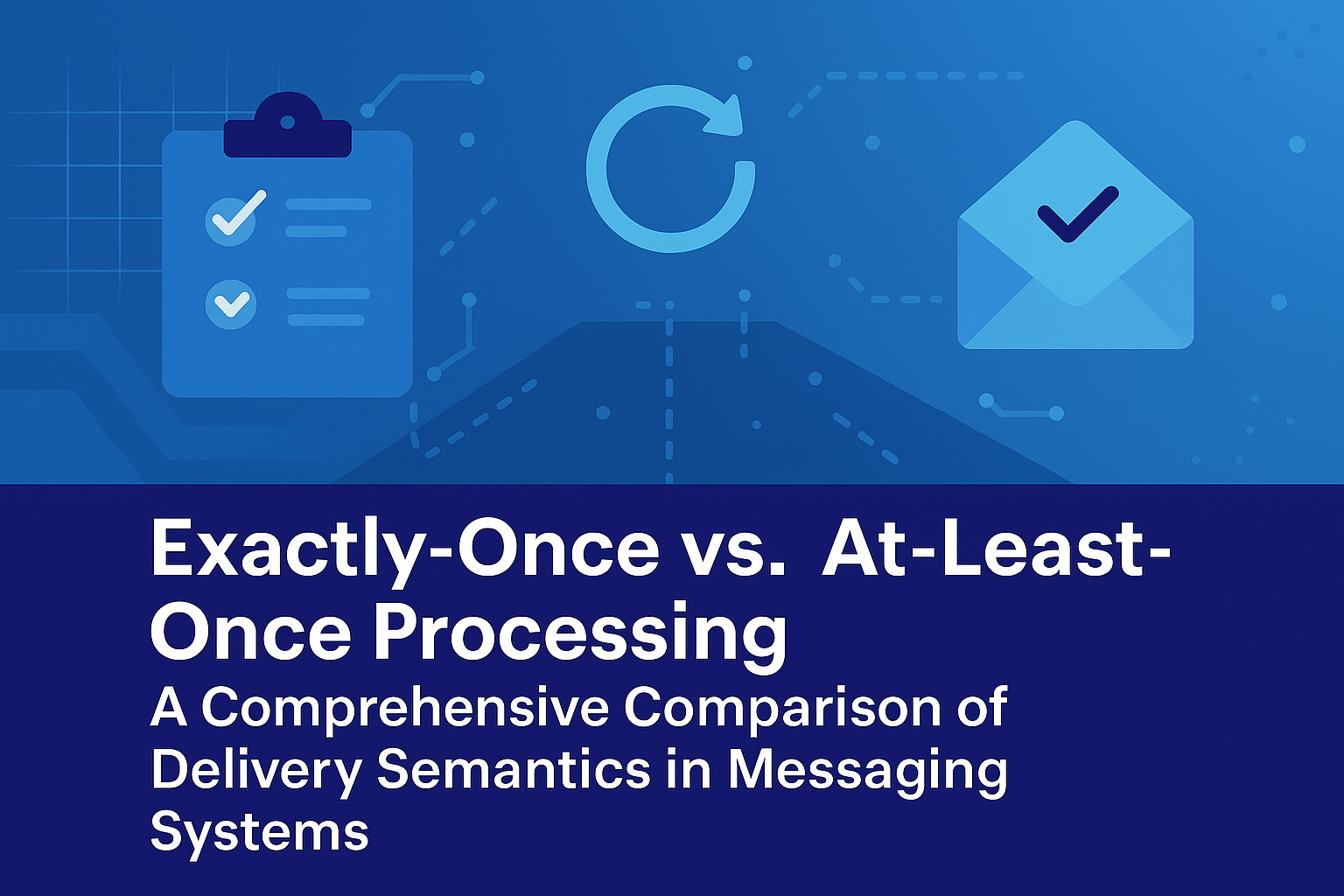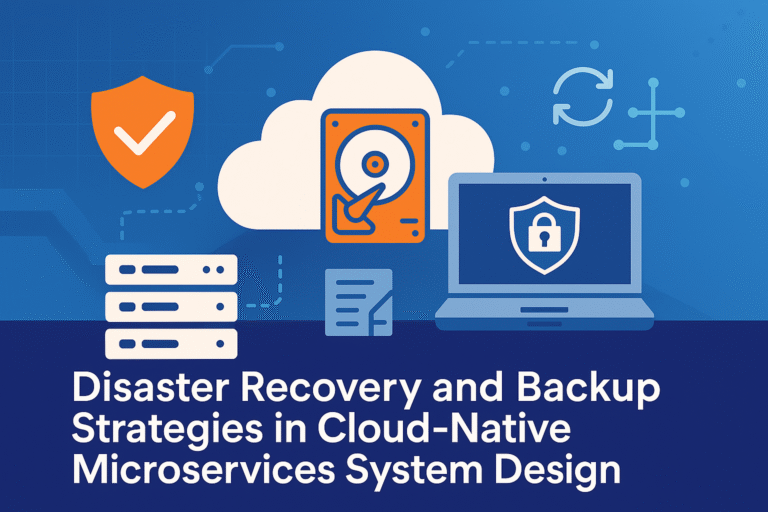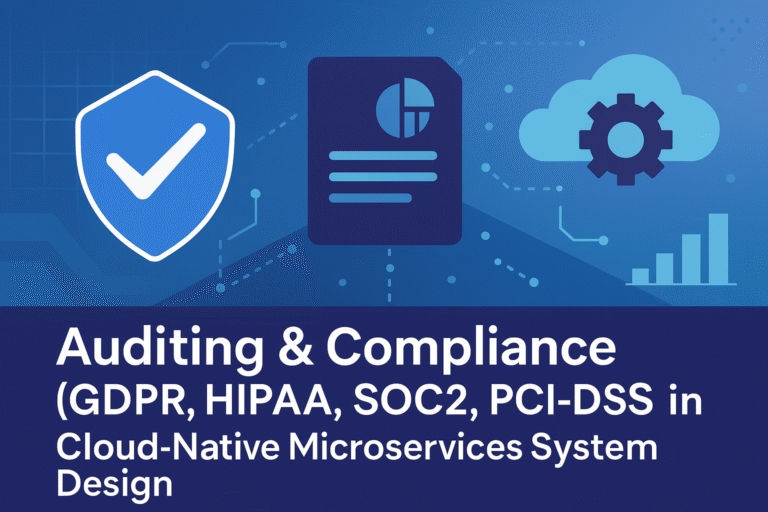Introduction
In distributed messaging systems, delivery semantics define how messages are guaranteed to be delivered and processed between producers and consumers. Two critical semantics are exactly-once and at-least-once, each balancing reliability, performance, and complexity in event-driven architectures. These semantics are pivotal for applications requiring precise data handling, such as financial transactions, real-time analytics, or IoT data processing, where message loss or duplication can lead to significant errors. Exactly-once processing ensures each message is delivered and processed precisely once, avoiding duplicates or losses, which is critical for applications like payment processing where duplicates could result in double-charging. At-least-once processing guarantees delivery of every message at least once, allowing duplicates but ensuring no loss, suitable for scenarios like log aggregation where duplicates are tolerable. This analysis provides a detailed comparison of these semantics, exploring their mechanisms, performance implications, use cases, advantages, limitations, and strategic trade-offs. It integrates prior concepts such as the CAP Theorem (prioritizing availability in AP systems), consistency models (strong for exactly-once, eventual for at-least-once), consistent hashing (for message partitioning), idempotency (for deduplication), unique IDs (e.g., Snowflake for message tracking), heartbeats (for system liveness), failure handling (e.g., retries), single points of failure (SPOFs) avoidance (through replication), checksums (for integrity), GeoHashing (for location-based routing), rate limiting (to control message flow), Change Data Capture (CDC) (for data ingestion), load balancing (for consumer scaling), quorum consensus (for coordination), multi-region deployments (for global reliability), and capacity planning (for resource allocation). The discussion offers a structured framework for system architects to select appropriate semantics for scalable, resilient messaging systems.
Delivery Semantics Defined
Exactly-Once Processing
Exactly-once processing guarantees that each message is delivered and processed exactly one time, ensuring no duplicates or losses, even in the presence of failures. This is the strongest delivery guarantee, critical for applications where correctness is paramount.
- Mechanism:
- Producer: Assigns unique IDs (e.g., Snowflake IDs) to messages and uses transactions to ensure atomic writes to the broker (e.g., Kafka transactions).
- Broker: Maintains message logs with replication (e.g., 3 replicas) and commits transactions only when all replicas acknowledge, using quorum consensus (e.g., KRaft in Kafka). Checksums (e.g., SHA-256) ensure message integrity.
- Consumer: Processes messages within transactions, committing offsets atomically with results to prevent reprocessing. Idempotency ensures safe retries by deduplicating based on unique IDs.
- Failure Handling: If a failure occurs (e.g., network partition per CAP Theorem), transactions roll back, and retries use idempotency to avoid duplicates. Heartbeats detect consumer failures for rebalancing.
- Mathematical Foundation:
- Reliability: Success probability = 1 − (1 − node_reliability)R, where R is replication factor (e.g., 99.999% with 3 replicas at 99.9%)
- Latency Overhead: Transaction commit time = write_time + replication_time + ack_time (e.g., 1 ms + 5 ms + 1 ms = 7 ms)
- Throughput Impact: Reduced by 10–20% due to transaction coordination (e.g., 800,000 messages/s vs. 1M/s for at-least-once)
At-Least-Once Processing
At-least-once processing ensures every message is delivered at least once, allowing duplicates but guaranteeing no loss. This is simpler and faster but requires consumer-side deduplication for correctness in some cases.
- Mechanism:
- Producer: Sends messages with retries on failure, without requiring transactions. Unique IDs enable consumer deduplication if needed.
- Broker: Stores messages with replication for durability, using heartbeats for broker liveness and load balancing (e.g., Least Connections) for distribution.
- Consumer: Acknowledges messages after processing, retrying on failures. Offsets are committed post-processing, risking duplicates if crashes occur before commits.
- Failure Handling: Retries ensure delivery, with rate limiting (e.g., Token Bucket) to prevent overload. Checksums verify integrity during retries.
- Mathematical Foundation:
- Reliability: Similar to exactly-once but tolerates duplicates (e.g., 99.99% delivery with retries)
- Latency: Lower than exactly-once, e.g., <5 ms end-to-end without transaction overhead
- Throughput: Higher, e.g., 1 M messages/s vs. 800,000 for exactly-once
Comparison of Exactly-Once and At-Least-Once
Structural Differences
- Guarantee: Exactly-once ensures one delivery/processing; at-least-once allows multiple deliveries.
- Complexity: Exactly-once requires transactions and coordination (e.g., quorum consensus); at-least-once is simpler, relying on retries.
- State Management: Exactly-once needs atomic state updates (e.g., offset and result commits); at-least-once may require consumer deduplication.
- Failure Impact: Exactly-once prevents duplicates during failures; at-least-once risks duplicates but ensures delivery.
Performance Comparison
| Aspect | Exactly-Once | At-Least-Once |
|---|---|---|
| Guarantee | No duplicates, no losses | Possible duplicates, no losses |
| Latency | Higher (e.g., 7ms due to transactions) | Lower (e.g., < 5ms) |
| Throughput | Reduced (e.g., 800,000 messages/s) | Higher (e.g., 1M messages/s) |
| Complexity | High (transactions, coordination) | Low (retries, optional deduplication) |
| Availability | 99.999% (replication, quorum) | 99.99% (replication, retries) |
| Scalability | Linear, but coordination overhead | Linear, minimal overhead |
Advantages and Limitations
Exactly-Once:
- Advantages:
- Correctness: Ensures precise processing (e.g., no double payments in banking).
- Reliability: No data loss or duplication, ideal for transactional systems.
- Auditability: Simplifies auditing with guaranteed single processing.
- Limitations:
- Performance Overhead: Transactions reduce throughput by 10–20% and add latency (e.g., 7ms vs. 5ms).
- Complexity: Requires transaction support in brokers/consumers, increasing setup effort (15–20% DevOps overhead).
- Resource Intensive: Higher CPU/memory usage for coordination (e.g., 20% more compute).
At-Least-Once:
- Advantages:
- High Performance: Lower latency (< 5ms) and higher throughput (1M messages/s).
- Simplicity: Easier to implement with retries, less broker coordination.
- Cost-Effective: Lower resource demands (e.g., 10% less compute than exactly-once).
- Limitations:
- Duplicates: Risks duplicate processing, requiring consumer deduplication (e.g., using unique IDs).
- Consistency: Eventual consistency may lead to temporary inaccuracies (e.g., 10–100ms lag).
- Complexity on Consumer: Deduplication logic adds consumer-side overhead (5–10%).
Use Cases with Real-World Examples
1. Exactly-Once: Payment Processing in Financial Services
- Context: A bank processes 500,000 transactions/day, requiring no duplicate charges or missed payments.
- Implementation: Transactions are published to a Kafka topic (“payments”) with 20 partitions, using Kafka transactions for exactly-once semantics. Producers assign Snowflake IDs for idempotency, and Flink consumers process transactions atomically, committing offsets and results together. Quorum consensus (KRaft) ensures broker coordination, heartbeats monitor consumer liveness, and multi-region replication supports global transactions. Checksums (SHA-256) verify message integrity, and rate limiting (Token Bucket at 100,000/s) controls ingress.
- Performance: < 10ms latency, 500,000 messages/s, 99.999% uptime.
- Trade-Off: Transaction overhead reduces throughput (800,000/s vs. 1M/s) but ensures correctness.
- Strategic Value: Guarantees no financial errors, critical for compliance (e.g., PCI DSS).
2. At-Least-Once: Log Aggregation in E-Commerce Analytics
- Context: An e-commerce platform aggregates 1M user interaction logs/day for analytics, where duplicates are tolerable but loss is not.
- Implementation: Logs are published to a RabbitMQ exchange (“user_events”), routed to queues. Consumers (e.g., Spark Streaming) process logs with at-least-once delivery, using idempotency (Snowflake IDs) for deduplication. Load balancing (Least Connections) distributes consumer tasks, heartbeats ensure liveness, and CDC feeds logs from databases. Multi-region queues support global analytics, with rate limiting to cap bursts.
- Performance: < 20ms latency, 1M messages/day, 99.99% uptime.
- Trade-Off: Duplicate risk (mitigated by deduplication) allows higher throughput and simpler setup.
- Strategic Value: Cost-effective for non-critical analytics, tolerating minor inconsistencies.
3. Exactly-Once: IoT Sensor Data Processing in Manufacturing
- Context: A factory processes 1M sensor readings/s, needing precise state updates for machine monitoring without duplicates.
- Implementation: Sensors publish to a Pulsar topic (“sensors”) with 100 segments, using transactions for exactly-once delivery. Flink consumers update state (e.g., temperature averages) atomically, with GeoHashing for location-based routing. Quorum consensus ensures segment consistency, heartbeats detect failures (< 5s failover), and checksums verify integrity. Multi-region replication supports global factories.
- Performance: < 10ms latency, 1M readings/s, 99.999% uptime.
- Trade-Off: Higher complexity ensures no duplicate alerts, critical for safety.
- Strategic Value: Prevents erroneous machine shutdowns, enhancing reliability.
4. At-Least-Once: Notification System in Social Media
- Context: A social media platform sends 100,000 notifications/day, where duplicates are acceptable but loss is not.
- Implementation: Events are published to an SQS queue (“notifications”) with at-least-once delivery. Lambda consumers process notifications, using idempotency for deduplication. Rate limiting (AWS throttling) controls flow, and CDC logs events to DynamoDB. Multi-region queues ensure global delivery, with AWS-managed fault tolerance.
- Performance: < 20ms latency, 100,000 messages/s, 99.99% uptime.
- Trade-Off: Simpler setup and higher throughput at the cost of potential duplicates.
- Strategic Value: Cost-effective for non-critical notifications, leveraging serverless simplicity.
Integration with Prior Concepts
- CAP Theorem: Exactly-once aligns with CP for strong consistency (transactional commits); at-least-once favors AP for availability (retries).
- Consistency Models: Exactly-once ensures strong consistency; at-least-once allows eventual consistency.
- Consistent Hashing: Distributes messages across partitions in Kafka/Pulsar.
- Idempotency: Critical for both, ensuring safe retries (exactly-once) or deduplication (at-least-once).
- Heartbeats: Monitors consumer liveness for rebalancing.
- Failure Handling: Retries in at-least-once, transactions in exactly-once.
- SPOFs: Replication avoids SPOFs in brokers.
- Checksums: SHA-256 ensures message integrity.
- GeoHashing: Routes messages by location in both semantics.
- Load Balancing: Least Connections for consumer tasks.
- Rate Limiting: Token Bucket caps message rates.
- CDC: Feeds messages into pipelines.
- Multi-Region: Replication for global delivery.
- Capacity Planning: Estimates brokers (e.g., 10 for 1M messages/s).
Trade-Offs and Strategic Considerations
- Correctness vs. Performance:
- Trade-Off: Exactly-once ensures correctness but reduces throughput (10–20% overhead); at-least-once maximizes throughput but risks duplicates.
- Decision: Use exactly-once for transactional systems (e.g., banking), at-least-once for analytics (e.g., logs).
- Interview Strategy: Justify exactly-once for payments, at-least-once for notifications.
- Complexity vs. Simplicity:
- Trade-Off: Exactly-once requires complex transaction coordination (15–20% overhead); at-least-once is simpler but shifts deduplication to consumers.
- Decision: Use exactly-once for critical systems, at-least-once for simpler setups.
- Interview Strategy: Propose exactly-once for IoT, at-least-once for e-commerce analytics.
- Cost vs. Reliability:
- Trade-Off: Exactly-once increases compute costs ($0.05/GB/month for transactions); at-least-once is cheaper but less reliable.
- Decision: Use exactly-once for high-stakes, at-least-once for cost-sensitive.
- Interview Strategy: Highlight exactly-once for manufacturing, at-least-once for social media.
- Scalability vs. Consistency:
- Trade-Off: Exactly-once scales with coordination overhead; at-least-once scales easily but risks inconsistencies.
- Decision: Use exactly-once for consistent needs, at-least-once for high-scale.
- Interview Strategy: Propose at-least-once for high-throughput analytics.
- Global vs. Local Optimization:
- Trade-Off: Exactly-once ensures global consistency but adds latency (50–100ms in multi-region); at-least-once is faster but less consistent.
- Decision: Use exactly-once for global critical apps, at-least-once for regional.
- Interview Strategy: Justify exactly-once for global payments.
Advanced Implementation Considerations
- Deployment: Use Kubernetes for Kafka/Pulsar/Flink with 10 brokers/nodes, SQS for serverless, RabbitMQ on clusters.
- Configuration:
- Exactly-Once: Enable transactions (Kafka/Pulsar), set replication factor 3, use Snowflake IDs.
- At-Least-Once: Enable retries, configure deduplication with unique IDs.
- Performance Optimization:
- Use SSDs for < 1ms I/O in Kafka/Pulsar.
- Enable GZIP compression (50–70% network reduction).
- Cache offsets in Redis (< 0.5ms access).
- Monitoring:
- Track throughput (1M/s), latency (< 10ms), and lag (< 100ms) with Prometheus/Grafana.
- Alert on > 80% utilization via CloudWatch.
- Security:
- Encrypt messages with TLS 1.3.
- Use IAM/RBAC for access.
- Verify integrity with SHA-256 checksums.
- Testing:
- Stress-test with JMeter (1M messages/s).
- Validate failover (< 5s) with Chaos Monkey.
- Test duplicate scenarios for at-least-once.
Discussing in System Design Interviews
- Clarify Requirements:
- Ask: “What’s the throughput (1M messages/s)? Latency (< 10ms)? Duplicate tolerance (0%)? Criticality?”
- Example: Confirm 500,000 transactions/s for banking with no duplicates.
- Propose Semantics:
- Exactly-Once: “Use for banking payments with Kafka transactions.”
- At-Least-Once: “Use for log aggregation with RabbitMQ.”
- Example: “For IoT, implement exactly-once with Pulsar.”
- Address Trade-Offs:
- Explain: “Exactly-once ensures correctness but adds latency; at-least-once is faster but risks duplicates.”
- Example: “Use exactly-once for payments, at-least-once for notifications.”
- Optimize and Monitor:
- Propose: “Use transactions for exactly-once, monitor throughput with Prometheus.”
- Example: “Track payment processing latency.”
- Handle Edge Cases:
- Discuss: “Mitigate duplicates with idempotency, ensure delivery with retries.”
- Example: “For social media, use deduplication for notifications.”
- Iterate Based on Feedback:
- Adapt: “If duplicates are tolerable, switch to at-least-once; if critical, use exactly-once.”
- Example: “For analytics, shift to at-least-once for cost savings.”
Conclusion
Exactly-once and at-least-once processing offer distinct trade-offs in messaging systems, with exactly-once ensuring correctness for critical applications (e.g., payments, IoT) at the cost of complexity and performance, and at-least-once prioritizing simplicity and throughput for less critical use cases (e.g., logs, notifications). Integration with concepts like idempotency, quorum consensus, and multi-region replication enhances reliability, while trade-offs like correctness vs. performance guide selection. Real-world examples from banking, e-commerce, manufacturing, and social media illustrate practical applications, achieving < 10ms latency and 99.999% uptime for exactly-once. By aligning with application requirements and monitoring metrics, architects can design messaging systems that balance reliability, scalability, and efficiency for modern distributed environments.




